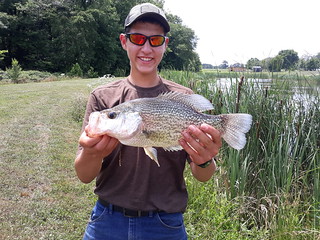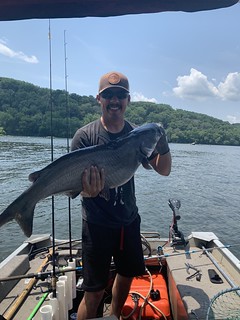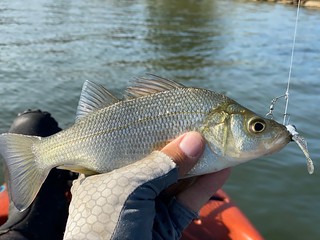Maryland Fishing Report – July 7
July is providing some exciting promise for Chesapeake Bay anglers as reports of cobia, bluefish, and Spanish mackerel entering the lower Bay are becoming more common. Offshore of the Atlantic Coast, fishing for sea bass is excellent right now.
Anglers are reminded of the upcoming striped bass closure period in the Chesapeake Bay from July 16 through July 31, to lessen catch-and-release mortalities of undersized striped bass.
Hot summer weather creates tough conditions for striped bass survival, which is also why DNR introduced its striped bass fishing advisory forecast for the warmest months each year, so anglers can better plan their fishing for striped bass to lessen mortalities.
Forecast Summary: July 7 – July 13:
Sunny, very warm weather all this week should continue to warm Bay water temperatures toward their typical peak in July. Bay surface water temperatures and river and stream temperatures are in the lower 80s, and will continue to rise this week. June monitoring data is showing main Bay bottom waters are slightly cooler than surface waters and beginning to show some poor oxygen conditions, so in some locations Bay gamefish will be higher in the water column to find adequate oxygen and their preferred water temperatures. In addition, the coolest oxygenated bottom waters can be found from the Kent Island area north to Tolchester. Cool water is also present on the Susquehanna River down through the Susquehanna Flats area in the late evening and early morning due to evening Conowingo Dam water release. Bay surface temperatures cool by about 2 degrees to 3 degrees at night.
Due to low bottom oxygen levels, avoid fishing below the following depths in these locations: Swan Point, 25 feet; Bay Bridge to Bloody Point, 15 feet to 25 feet; Choptank River to Point No Point, 35 feet to 45 feet. On the Potomac River from Colonial Beach to Piney Point, avoid fishing deeper than 15 feet to 35 feet. Along the western shore, avoid fishing deeper than 15 feet. Conditions can vary daily so be sure to check the depth-to-oxygen level online prior to your next fishing trip.
Maryland upper Bay waters south to the Bay Bridge are running saltier than normal, while the lower Bay from Tilghman Point down to Cove Point are running fresher than normal. Expect average flows for most Maryland rivers and streams. There may be localized high flows from rain on Thursday. There will be above average tidal currents all week because of the new moon July 10.
Expect average clarity for Maryland portions of the Bay and rivers, but expect poorer water clarity due to algal blooms in the Back and Bush rivers. To see the latest water clarity conditions, check Eyes on the Bay Satellite Maps.
For more detailed and up-to-date fishing conditions in your area of the Bay, check the Maryland DNR website for Click Before You Cast. Get regular updates on Maryland’s waters sent to your inbox with our Eyes on the Bay newsletter. Sign up online.
Fishing for striped bass at the Conowingo Dam pool continues to be an early morning affair. The dam is on an afternoon power generation schedule and in the mornings there is hardly any flow from the dam. Anglers casting topwater lures and paddletails in the dam pool are catching striped bass in good numbers, with a fair percentage measuring under 19 inches. The action is much the same down at the Susquehanna Flats edges, where evenings also are providing action. Casting topwater lures and paddletails is the mainstay, and jigging with soft plastics along deeper channel edges works during the brighter daylight hours. The mouths of the region’s tidal rivers can present similar action.
The area between Pooles Island and Rock Hall, which is often called the Tolchester Lumps, continues to be the focus of every boat full of anglers that can make the trip. Anglers are live-lining spot on the striped bass that are holding on the shallow lumps or shoals the blanket the area. The boats that arrive early find the best concentrations of fish and the best action. Water temperatures have risen above the 80-degree mark which places striped bass under a lot of stress. It is advisable to be careful when releasing sub-legal fish, and anglers who catch their limit should discontinue catch-and-release fishing. The use of circle hooks is mandatory when targeting striped bass with live or cut bait. To protect undersize fish from heat and stress, striped bass fishing will be closed in the Chesapeake Bay from July 16 through July 31, and until then anglers should check the striped bass fishing advisory forecast to plan their fishing and help lessen mortalities.
Anglers that do not wish to bump gunwales with other boats at the Tolchester Lumps can find suspended striped bass with a little bit of exploration in other areas of the upper Bay. The Love Point Rocks, Swan Point, the mouth of the Patapsco near the Key Bridge, and the mouth of the Sassafras River are all good places to take a look with a depth finder. Jigging with soft plastics can work in these same areas and trolling along the channel edges in the Bay can produce some action. There is a fair amount of striped bass action around the Bay Bridge piers for those casting soft plastic jigs up close to the piers or live lining spot in the early morning hours.
Fishing for blue catfish is extremely good in the lower Susquehanna River and surrounding areas. The upper Chester River and other tidal rivers in the region also hold populations of blue and channel catfish. Fresh cut bait of menhaden and gizzard shad are top baits, but nightcrawlers, chicken livers and clam snouts can work well also.
White perch fishing remains good in the region’s tidal rivers. Casting small jigs, spinners, and beetle spins in the morning and evening hours along shoreline structure is a fun way to fish for them. Using bottom rigs baited with grass shrimp or pieces of bloodworm are a good way to fish for them in deeper waters. Spot and white perch can be found at the mouth of the Chester and Magothy rivers and at the shallower areas of the Bay Bridge and Sandy Point State Park on hard bottom.
Some of the best striped bass fishing is occurring in the early morning hours along the shorelines of the Bay and lower regions of the tidal rivers. The Poplar Island Rocks, Thomas Point, Eastern Bay, Severn River, and the mouth of the Choptank are all good places to cast topwater lures and paddletails to shoreline structure. There are a fair percentage of sub-legal fish but plenty of larger striped bass. Speckled trout can also be part of the mix when casting 3-inch to 4-inch white or pink paddletails with quarter-ounce jig heads.
Although they are in lesser numbers than anglers would like to see, striped bass can be found with depth finders suspended along the edges of the shipping channel and other channels. Once found, live spot is one of the more popular options, but jigging with soft plastic jigs is another viable option. To a lesser extent trolling along the channel edges with umbrella rigs or tandem bucktails can work. The fish tend to be holding at about 25 feet to 30 feet.
Fishing for white perch has been very good in the tidal rivers and creeks. Casting small jigs, spinners, and beetle spins is a fun way to fish in the morning and evening hours. Shoreline structure is a good place to try. Fishing with a bottom rig baited with grass shrimp or pieces of bloodworm in deeper waters around docks and oyster bottom is another good option. Spot can be found on hard bottom in most areas of the middle Bay. The backside of Hacketts Bar, Eastern Bay. and the east side of Tilghman Island are a few good locations.
Fishing for a mix of blue catfish and channel catfish in the region’s tidal rivers is good this week. The upper Choptank River and the Tuckahoe Creek hold some of the largest blue catfish populations in the region. Fresh-cut menhaden and gizzard shad are popular baits, as are chicken liver and nightcrawlers.
Anglers are finding some of the best striped bass fishing in the lower Potomac and Patuxent rivers and along shoreline structure areas within the lower Bay region. The channel edges below the Route 301 Bridge and the mouth of the Patuxent in 30-foot waters are good places to find striped bass suspended close to the bottom. Some are trolling with umbrella rigs but most are live-lining spot or jigging with soft plastic jigs.
Striped bass fishing in the Virginia waters of the Chesapeake Bay has been closed since June 16 and will reopen on October 4; only catch-and-release fishing of striped bass is allowed during this time. The main stem of the Potomac River is now closed to striped bass fishing from July 7 through Aug. 20 (please note this a corrected date from what we previously reported). Maryland’s Bay waters will be closed to all striped bass fishing from July 16 through July 31.
Anglers who are out casting a mix of paddletails and topwater lures in the shallower waters in the early morning hours are enjoying a mix of striped bass and speckled trout. White and pink paddletails in the 4-inch size range with quarter-ounce jig heads are very popular. Poppers and Zara Spooks are the most popular topwater lures. Some shoreline structure areas to target include docks and bulkheads, rock piles, grass flats, prominent points, and the mouths of creeks. A high flood tide offers some of the best fishing opportunities. Another option when targeting speckled trout is to drift peeler or soft crab baits in the deeper spots at the mouths of small creeks on the early stages of an ebb tide.
Cobia fishing is very good this week and Smith Point tends to be the best location for Maryland anglers to chum with fresh menhaden baits. The Middle Grounds and the Target Ship are other locations to check for cobia. Persistent southerly winds have kept the Bay waters choppy, which makes sight fishing for cobia very difficult. Trolling red and green hoses is another option to fish for cobia. When the waters calm down casting live eels or large soft plastic jigs is always an exciting and effective way to fish for cobia.
Bluefish are moving into the region this week and can be caught by trolling, casting to breaking fish, or as an incidental catch when chumming for cobia.
Large red drum are providing some exciting catch-and-release action near the Target Ship, Tangier Sound, and the Middle Grounds. Most are holding weighted soft crab rigs and watching depth finders for confirmation of a school of large red drum before dropping baits. Slicks and birds can also mark the way to schools of feeding red drum at times. As the month progresses, schools of Spanish mackerel and bluefish chasing bait will also be a good indicator, since red drum will often hold underneath the surface action. Jigging with large soft plastic jigs and trolling large metal spoons behind inline weights is another good option.
There are plenty of spot to be found in the lower Patuxent River, Cornfield Harbor near Point Lookout, and the Tangier Sound area. Most of the spot being caught are of excellent size for live-lining, but a growing percentage are becoming large enough to pan fry. White perch are plentiful and can be found mixed in with the spot or along shoreline structure.
Recreational crabbing has met with limited success in the lower Bay tidal rivers and creeks but catches of a few dozen good blue crabs is possible. Crabbing success tends to improve in the middle and upper Bay with up to a half bushel of crabs possible per outing. Success can be very spotty depending on location and luck. Depths from 8 feet to 15 feet seem to be the sweet spot and transition edges or slopes offer some of the best trotline lays. A bright spot for the future are the reports of small crabs showing up in the lower and middle Bay in the past week.

Ronaldo Clara caught and released this fine looking crappie in a southern Maryland farm pond. Photo courtesy of Ronaldo Clara
Recent electrofishing surveys on the North Branch of the Potomac River zero-creel trout management area, between Westernport and the Black Oak Fishery Management Area, showed healthy populations of trout in a desirable size. These types of trout management areas offer exciting catch-and-release fishing opportunities. The recent survey showed a population structure of 86% rainbow trout and 14% brown trout.
Other electrofishing surveys recently took place at Deep Creek Lake and Broadford Lake. Both showed healthy populations of fish, and Deep Creek Lake showed an excellent population of trophy-sized bluegills and largemouth bass. A standout at Broadford Lake was the population of large crappie waiting for anglers.
Fishing for smallmouth bass in the upper Potomac River tends to be an early morning affair as water temperatures are around the 80-degree mark, and the water is low and clear. Light lines, long casts, and careful approaches to submerged ledges and boulder pockets are needed. A variety of tubes, craws, small crankbaits, and soft plastic swimbaits offer good choices for baits.
Largemouth bass are following the same summer routine of feeding at night and loafing in cool shade where they can find it, whether they are in tidal or nontidal rivers, reservoirs, or ponds. The early morning and late evening offer the best time to fish the shallower waters where largemouth bass are feeding. Frogs, chatterbaits, and other topwater lures are good choices for this type of fishing. As the daylight hours prevail, dropping wacky-rigged stick worms or soft plastic worms down through thick grass is a good way to entice a lounging bass to pick up a bait. Fallen treetops, sunken wood, docks, and moored boats are other good places to target during the sunnier times of the day. In tidal waters — and unfortunately an increasing number of nontidal areas — northern snakeheads will be found in shallow grass and will strike the same lures used for largemouth bass.

One never knows what can happen when fishing in the broad expanse of the ocean and Greg Eckard proves that with this bigeye tuna. Photo courtesy of Greg Eckard
Surf conditions have calmed down and good fishing is possible. Most surfcasters are targeting kingfish with small baits of bloodworms or Fishbites. Spot are very much in the mix, and using strips of spot belly is a good way to target the flounder and small bluefish that are present in the surf zone.
At the inlet, flounder are being caught along with a mix of medium-sized bluefish and sub-legal striped bass that measure short of the required 28 inches. Most are being caught on soft plastic jigs and bucktails. A few anglers are drifting cut baits off the Route 50 Bridge with moderate success. Anglers are reminded that when targeting striped bass using cut or live bait, circle hooks are required.
In the back bay waters, flounder fishing is improving as water clears up from recent wind and wave action. The East Channel and the Thorofare are good places to target flounder, as are the channels near the Route 90 Bridge and out in front of the Ocean City Municipal Airport. Traditional baits of squid, smelts, and live minnows work well, but working the bottom with large Gulp plastics in pink and white with a jighead can often help target larger flounder.
The offshore wreck and reef sites are providing excellent fishing for sea bass, and limit catches are common. Large flounder are also being caught at the same sites, often by those who have caught their limit on sea bass. The yellowfin tuna fishery at the canyons is slow this week but could improve at any time. Many of the yellowfin being caught are small and charters are focusing on deep dropping for blueline and golden tilefish before returning to the docks.
Highly migratory species are being caught off the Maryland coast. The Department of Natural Resources reminds anglers that a catch card must be completed and exchanged for a tag to land bluefin tuna, swordfish, billfishes, or sharks in Maryland. Details and forms for the Catch Card Census are available on the DNR website.
“The finest gift you can give to any fisherman is to put a good fish back, and who knows if the fish that you caught isn’t someone else’s gift to you?” — Lee Wulff
Maryland Fishing Report is written and compiled by Keith Lockwood, Maryland Department of Natural Resources fisheries biologist.
Click Before You Cast is written by Tidewater Ecosystem Assessment Director Tom Parham.
This report is now available on your Amazon Echo device — just ask Alexa to “open Maryland Fishing Report.”






 1-888-373-7888
1-888-373-7888 233733
233733